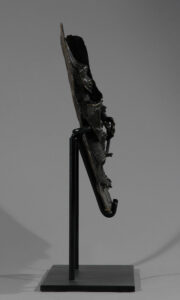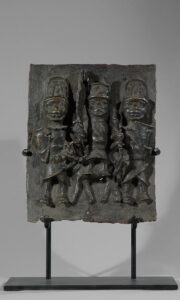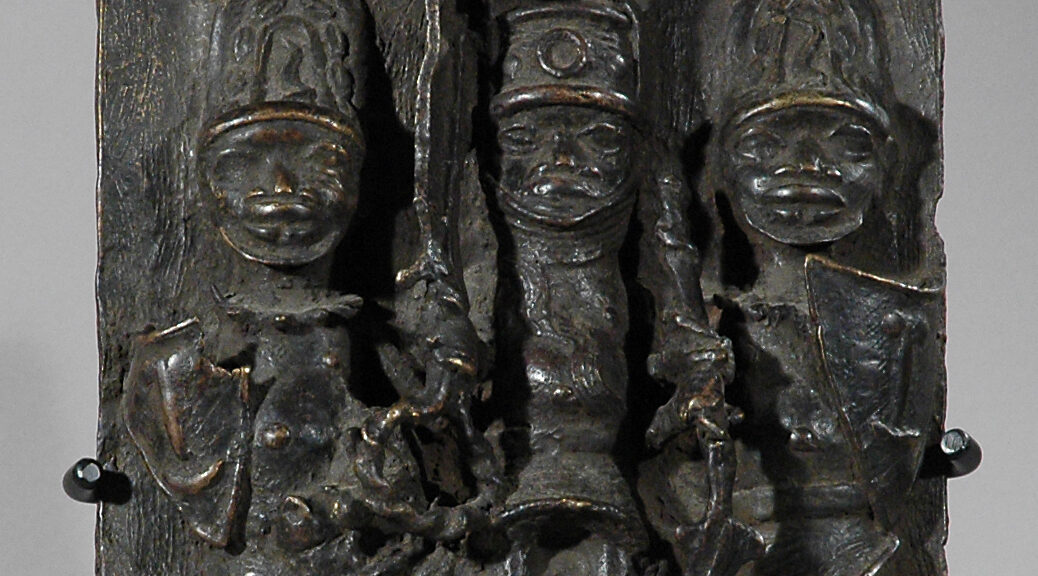   
CMK 0406-2 Benin Bronze Plaque, Nigeria. This type of Benin-bronze plates which display a high rank person guarded by two guards, in its time consisted of several thousand plates that lined and decorated the royal palace in the kingdom of Benin, which is now present-day Nigeria. Royal Benin Bronze Plaques lake this can be seen at the British Museum’s collection of Benin Art, which note that their exhibition shows more than 300 Royal Benin bronze plaques originating from acquisitions from the looted artefacts that the Royal British Navy brought home after the destruction of Benin King Obama’s palace. in 1897 and robbing more than 4,000 artefacts and murdering sections of the population and burning down the royal palace. Read about the terrible “The Benin massacre and expedition of 1897” at: https://oldnaija.com/2017/03/17/benin-massacre-and-expedition-of-1897/ The fascination in Europe with discovering Benin’s art can be explained by the prevailing taste for antiques and by the nature of the works, that is, a royal art entirely dedicated to honoring the sovereign or Oba and his court. Benin works of art brought back from Africa during the expedition were acquired by many major European museums at the time, including the British Museum, London; Natural History Museum, Vienna; Museum of Ethnology, Dresden; Ethnological Museum, Berlin; as well as museums in Leipzig, Cologne, Munich and others. In 1668, Olfert Dapper (quoted after Falgayrettes-Leveau 1989: 230) described the royal palaces of Benin and the bronze plates that decorated them in the following terms: “There are several apartments for the prince’s ministers and fine galleries, most of them as large as “They are supported by wooden pillars, lined with brass and engraved with their victory, and special emphasis is placed on keeping them very clean.” Most of the records recorded today show court scenes or war scenes, important events in Oba life. This offered plaque shows a cast figure, probably a war commander or a chief. He wears an unusual hat. The shape of the hat is reminiscent of a grenadier hat. In the late 1600s, the wide brims of traditional military hats were in conflict with the grenadier’s throwing arm, and a hat without the brim was devised that quickly spread throughout the European military (Wilcox 1959: 114, 149 in Abbass 1972: 44). The hat worn by the figure on the plaque was more than likely modeled on a Portuguese form of grenadier hats. The Benin Kingdom had been in a trade relationship with Portuguese merchants since the 15th / 16th century, and influences from this contact can often be seen in Benin art. The high ranked person is flanked by two armed guards, each with feather decorated hats, weapons, and shields. The vast majority of Benin’s artworks was designed to honour the achievements and/or memory of the Obas, the divine rulers of the Benin polities. Until the late 19th century, the Benin centres were a ruling power in Nigeria, dominating trade routes and amassing enormous wealth as the military and economic leaders of their ancient empire. This changed with the appearance of the British forces, which coveted the wealth of the royal palaces and found a series of excuses to mount a punitive expedition against the Oba’s forces in 1897. It was only at this point, the moment of its’ destruction, that the true achievements of the Benin polities became apparent to western scholars. The palaces were a sprawling series of compounds, comprising accommodation, workshops and public buildings. As it grew, the buildings pertaining to previous Obas were either partially refurbished or left in favour of newer constructions; this led to a long history of royal rule written in sculptural works that rank among the finest that African cultures have ever produced. The technology of bronze and copper smelting, ironworking and sculpting in a range of materials that particularly included ivory was extremely refined and effective; indeed, smelting, forging and cire perdue (lost wax) metalworking methods exceeded any seen in Europe until the 19th century. Perhaps the most valuable and remarkable objects made by the Benin craftsmen are the bronze/copper plaques that were cast in sections, assembled, and nailed to the walls to mark the achievements of the Obas. These are a perfect history of the palace system, dating from the early 16th to the 19th centuries, containing reference to all aspects of courtly life and events such as the arrival of Portuguese troops. |
|
| This type of Benin-bronze plates in its time consisted of several thousand plates that lined and decorated the royal palace in the kingdom of Benin, which is now present-day Nigeria. In 1897, however, most plaques and other objects were looted by British forces during a punitive expedition to the area as imperial control was consolidated in southern Nigeria. Two hundred of the pieces were brought to the British Museum, London, while the rest were purchased by other European museums. And can be seen in remarkable collections are in Germany and the United States.
Not only was the Benin Kingdom both rich but far more highly developed in African culture and art. In fact, the Benin Empire was a hub of African civilization before the Portuguese merchants visited the country and it is clear that the bronzes were made in Benin from an indigenous culture. Many of these dramatic sculptures are from the thirteenth century, centuries before contact with Portuguese merchants, and much of the collection dates from the 15th and sixteenth centuries. It is believed that two “golden ages” in Benin metalworking occurred during the reigns of Esigie (fl. 1550) and Eresoyen (1735–50), when their execution attained its highest qualities. The kings employed ‘bronze casters’, who were regarded as prestigious occupations and made ornaments and portraits of members of the royal family as well as animal motifs, with the leopard being the most significant royal symbol. And it was not only for their own use that these specialists cast bronze figures for there were also guilds anatte, who took care of the monitoring of the bronze production as well as the business part. All bronze casting was performed using bronze and copper smelting, ironworking and sculpting in a range of materials that particularly included ivory was extremely refined and effective; indeed, smelting, forging and cire perdue (lost wax) metalworking methods exceeded any seen in Europe until the 19th century. |
|
Perhaps the most valuable and remarkable objects made by the Benin craftsmen are the bronze/copper plaques that were cast in sections, assembled, and nailed to the walls to mark the achievements of the Obas. These are a perfect history of the palace system, dating from the early 16th to the 19th centuries, containing reference to all aspects of courtly life and events such as the arrival of Portuguese troops. There were once thousands of these objects, but the majority were taken as booty by British soldiers and were even auctioned off in Southampton docks after their return to England. As a result, many have vanished, and the remaining examples are very rare (about 900 are known). There is stylistic drift between the earliest and the latest examples.
The current example is believed to date to the very end of the 19th century and is therefore contemporary with the European invasion and enormous social changes wrought in the Benin polity. The figures are in comparatively low relief, with relatively little addenda after the original casting. depicted in 17th century examples. The two guards seemingly belong to different regiments or divisions, as indicated by their different headwear. The fact that the figure to the right of the panel appears to be holding the bridle of the horse hints at a distinct role for this individual. They are wearing identical leopard-branded tunics, which were designed to intimidate their enemies in battles.
Age: Est. Late 19th Century AD
Measure: H: 33, W: 29, D: 7 cm – Weight: 4.650 kilos
Condition: This plaque has despite age no damage and probably been placed out in the open since it is covered by a thick becomingly layer of dark green verdigris.
Provenance: Belgian private collection and acquiredvia Brussels art dealer.
Suggested readings:
- Plankensteiner, Benin kings and rituals: court arts from Nigeria(Paris/Berlin, 2007).
- Girshick Ben-Amos, The Art of Benin(London, 1995).
- Alfert, “Relationships between African tribal art and modern western art,” Art Journal31 (1972), 387-396.
- Barkan, “Aesthetics and evolution: Benin art in Europe,” African Arts 30, no. 3 (1997,) The Benin Centenary, pp. 36-93.
S.B. Alpern, “What Africans got for their slaves: a master list of European trade goods,” History in Africa 22 (1995), 5-43.
B.W. Blackmun, “From trader to priest in two hundred years: the transformation of a foreign figure on Benin ivories,” Art Journal 47 (1988), 128-138.
S.P. Blier, “Imaging otherness in ivory: African portrayals of the Portuguese, ca 1492,” Art Bulletin 75 (1993), 375-396.
- Eyo, “The dialectics of definitions: “massacre” and “sack” in the history of the Punitive Expedition,” African Arts 30, no. 3 The Benin Centenary, pp. 34-5.
J.D. Fage, “Slavery and the slave trade in the context of West African history,” Journal of African History 10(1969), 393-404.
Request price for Bronze Plaque
